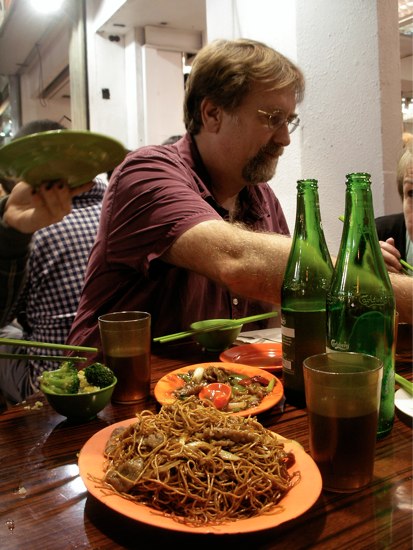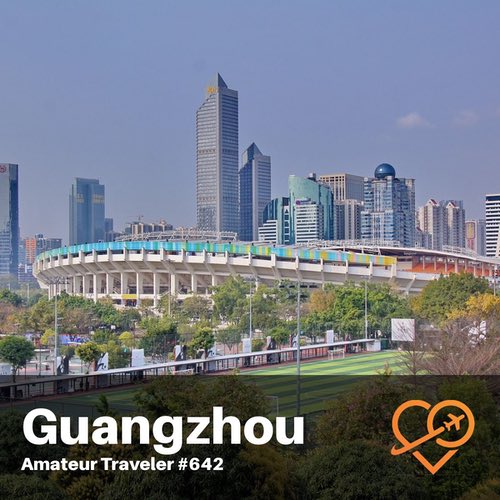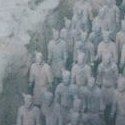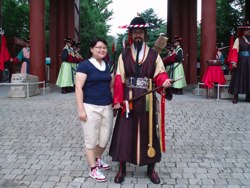Travel to Hong Kong – Episode 233
categories: asia travelThe Amateur Traveler talks to Melody who has been living as an exchange student in Hong Kong.
Melody tells us what to see in Hong Kong from the very western feeling Central neighborhood of Hong Kong island, the peak and the mid-level escalators to the more Chinese neighborhoods in Kowloon and the less populated New Territories.
She also takes us out to some of the outlying islands like Lantau island with the Big Buddha & Po Lin Monastery, Cheung Chau Island with its famous bun festival, and the nearly uninhabited Po Toi Island.
We talk about the 10,000 Buddha Monastery with its add statues.
If you are a shopper and you are visiting Hong Kong then you have to visit the Temple Street Night Market. The market is about 4 blocks long on Temple Street near the Jordan MTR station. The night market is a place to buy clothing (although DO NOT try on clothing without asking first), trinkets, electronics, luggage, purses, craft supplies, knock-off watches and virtually any other manufactured product.
Even if you don’t like shopping Temple street is a wonderful place to visit and also a wonderful place to eat. We ate on the street sitting on plastic stools at the Tong Tai Seafood Restaurant. This restaurant provides great local food (Chinese food) including but not limited to seafood. The prices are very reasonable and the proprietor was wonderfully congenial. The crowd is a mixture of tourists and locals.
Order the garlic broccoli. I have to look for a recipe for this dish. We ate family style and had vegetarian, beef, chicken, shrimp, prawns, and pork dishes. Your bowl is to eat out of and your small plate is where you put the shells from your prawns, bones or anything else you don’t eat. Practice your chopstick skills before you go to Hong Kong.
We explore the fish, flower, bird and jade markets. Melody recommends the Star Ferry for a great view of Hong Kong island, especially at night.
For nightlife, Melody recommends Wednesday and Thursday nights when ladies often get free drinks. Her favorite nightspot is the Cavern and a famous one is the Fringe.
- Get a universal plug adapter
- Buy Travel Insurance
- Book Your Accommodation HERE
- Get a Car Rental
- Search for Great Tours HERE
- Get an eSim to be able to use your smartphone abroad.
right click here to download (mp3)
right click here to download (iTunes version with pictures)
News
Ryanair Fined 3 Million Euros for Abandoning Passengers
Travellers to be searched for porn
Accountant becomes first person guilty of posting ‘menacing’ Twitter message after threat to blow up airport
Show Notes
Hong Kong Travel Guide from the Amateur Traveler
Cheung Chau Island Bun Festival
Octopus Card
Olympic Terrace Suites – where we stayed
Thai Cambo – the Thai restaurant I couldn’t remember the name of in the episode
Internet Resources
Community
Contributing to the Amateur Traveler
iTunes… not so enhanced
Audible free book
Egypt Photo Tour
This Week in Travel
The Bible Study Podcast
+Chris Christensen | @chris2x | facebook
3 Responses to “Travel to Hong Kong – Episode 233”
Leave a Reply
Tags: audio travel podcast, china, hong kong, podcast, study abroad





 Travel to Hong Kong – Episode 636
Travel to Hong Kong – Episode 636 Travel to Guangzhou, China – Episode 642
Travel to Guangzhou, China – Episode 642 Travel to China – Episode 59
Travel to China – Episode 59 Travel to Seoul, South Korea – Episode 157
Travel to Seoul, South Korea – Episode 157

Pak
Says:May 23rd, 2010 at 9:27 am
Being born & raised in HK, it’s exciting to send in my comments on this episode.
1. Shamshuipo is a traditionally very blue-collar district, hence perhaps contribute to the impression that English is less used. Also after 1997, this area has been popular with the new immigrants from the Mainland, exactly bcos of its affordability as mentioned. The new comers usually have had less exposure to English than native population.
2. Central (the Middle Bay in Chinese) used to be the main piers for the British in the 1800’s, & then became the banking district later. The wealthy merchants & gov officials built their mansions on the steep hillside just behind the harbour. The Peak Tram was built for the rich folks to commute home & work comfortably, & at the time in state-of-the-art style.
3. The golden statues in the Ten Thousand Buddha Temple should be loosely considered as the equivalents of “Saints” instead. They are actually mostly human but legendarily devout Buddhists who often have special saintly attributes (eg Mr Fantastic). Think Ste Agathe – she is often depicted with her breasts on a platter.
4. The wide variety of delicious pastry, shown in the show pix, is actually a recent import from Japan. The egg tart (plain custard) is a native invention from the 40’s, & is thought to be a version of Pastel de Nata (w/ brown sugar) from the Portugese Macau nearby. “Paoloyow” means “Pineapple Bun w/ Butter”, where “Bow (Bun)” was dropped & “Yow (Grease)” was appended. Think “Frappucino”.
5. As a symbolic save-face, the Kowloon Walled City was created (agreed by both sides) to be the HQ of the Qing officials after the British took control of the colony. Within these few city blocks, the Qing Emperor still ruled until 1911. After, it became a virtually lawless slum since the Colonial Law did not apply there, & no police will enter this limbo land. Violence was usually not a big problem. However, the City was a haven for prostitution, drugs, unlicensed medical practices, & any contraband imaginable.
chris2x
Says:May 23rd, 2010 at 5:56 pm
Pak, thanks for the great info!
Agagooga
Says:June 6th, 2010 at 3:10 am
The main attraction for Singaporeans who go to Hong Kong seems to be eating and shopping. Unfortunately the historical aspect is not as strong as in Macau.
At the Giant Buddha, not only meat but also wine is forbidden. Which was quite amusing.
Delifrance is actually from Singaporean. Here it’s Halal, so they don’t serve wine (a French cafe with no wine?!) I saw it in Brussels… but not in France.
Are Ladies’ Nights so unusual? We have them in Singapore also. Maybe they’re a Chinese society thing? Which is an interesting commentary on gender dynamics in Chinese societies.
I’m told the standard of English has plummeted in Hong Kong since the handover.
Hong Kong is famous for roast pigeon and goose. Yung Kee is the most famous place for the latter.
The difference between Hong Kong and Macanese Egg Tarts goes beyond the carmalised brown sugar on top. The former usually have a short crust and the latter are more like filo pastry.
Dim Sum is a whole food genre by itself!